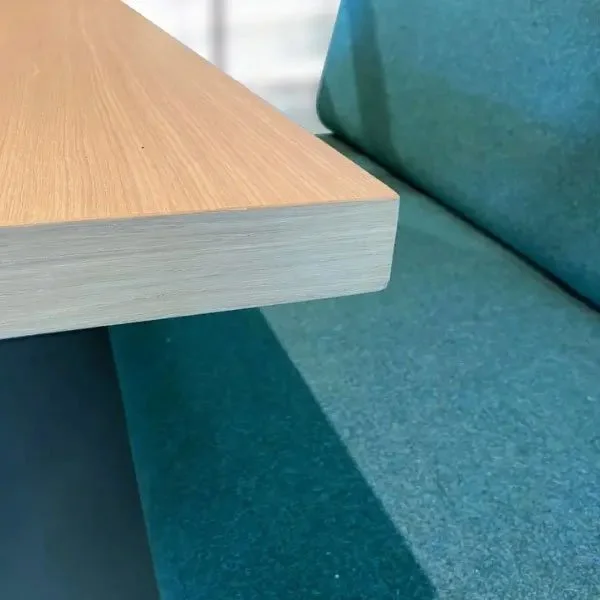co-Friendly Office Furniture Features
When designing modern offices that prioritize functionality, sustainability, and style, understanding the characteristics of eco-friendly office furniture is essential. This type of furniture minimizes environmental impact while promoting durability, health benefits, and aesthetic appeal. By choosing sustainable office furniture, you create a workspace that is not only environmentally friendly but also enhances employee well-being and productivity.
Sustainable Office Furniture: Materials and Production Processes
Sustainable office furniture is defined by its use of eco-friendly materials and ethical production processes. These reduce the furniture's environmental footprint throughout its lifecycle. We are committed to fair trade practices, ensuring ethical and socially responsible manufacturing. Our furniture is crafted from recycled wood, metals, and fabrics and finished with non-toxic coatings, ensuring it’s safe for indoor use while being environmentally conscious.
Durability and Design for Longevity
A key aspect of eco-friendly furniture is its durability. Thoughtful designs that use fewer materials help minimize environmental impact, while high-quality craftsmanship ensures the furniture lasts longer. This reduces the need for frequent replacements, saving resources and decreasing waste. Many sustainable office furniture options are modular and flexible, allowing them to adapt to evolving office layouts and needs, further extending their lifecycle.
End-of-Life Planning and Recycling
Sustainability also means considering the end of the furniture’s life. Sustainable office furniture is designed to be easily recycled, upcycled, or responsibly disposed of, preventing unnecessary landfill waste. By incorporating circular economy principles, the furniture can extend its usefulness while minimizing its overall environmental footprint.
Materials and Production
Renewable and Recycled Materials
Using renewable and recycled materials is central to eco-friendly furniture production. Here are some key materials:
Bamboo: A fast-growing, renewable resource that’s lightweight but incredibly durable for various applications.
Reclaimed Wood: Preserves forests by reducing the demand for new timber and adds a unique aesthetic to each piece.
Recycled Metals and Plastics: These materials help reduce waste and energy consumption compared to creating new resources.
Non-Toxic and Low-VOC Finishes
Traditional furniture can emit volatile organic compounds (VOCs) that pollute indoor air. Our sustainable furnitureuses safer alternatives, like:
Water-based finishes: Emit fewer VOCs and improve indoor air quality.
Natural oils and waxes: Non-toxic and derived from plants, enhancing the natural beauty of the wood.
Low-VOC adhesives: Help maintain a healthier indoor environment with reduced chemical emissions.
Sustainable Certifications
Certifications provide assurance of sustainability. When selecting eco-friendly office furniture, look for:
FSC (Forest Stewardship Council): Guarantees responsible forest management and ethical sourcing of wood.
GREENGUARD: Ensures low chemical emissions for healthier indoor environments.
BIFMA LEVEL: Evaluates furniture against strict environmental, social, and economic sustainability standards.
Durability and Design
Craftsmanship and Repairability
Sustainable office furniture is crafted to last. Using solid wood, reinforced joints, and high-quality upholstery ensures long-term durability. Many pieces are designed with modular components, allowing for easy repairs and replacements, which prolongs their life and reduces the need for new purchases.
Modular and Flexible Design
Modular designs enable sustainable furniture to be adaptable to changing office environments. This flexibility maximizes the furniture’s utility and extends its lifespan.
Reconfigurable workstations: Desks and workstations can be rearranged to accommodate team sizes and project needs.
Multi-purpose furniture: Convertible desks and tables serve multiple functions, optimizing space usage.
Look and Aesthetic
While sustainability is key, eco-friendly office furniture is also designed to be visually appealing. With natural materials and finishes, it creates a cohesive and beautiful workspace.
Natural wood grain and textures add a unique character to each piece.
Ergonomic designs ensure employee comfort, improving overall productivity.
End-of-Life and Recycling
Sustainable office furniture is built with recyclability in mind. Materials like aluminum, steel, and certain plastics can be repurposed, while wood and natural fibers can be composted depending on their finish. This focus on recyclability prevents the furniture from ending up in landfills.
Upcycling and Repurposing
Upcycling is another way to extend the furniture’s life. Old desks can be repurposed into storage units, or filing cabinets transformed into planter boxes. Donating used furniture to schools or non-profits further contributes to a circular economy and promotes social responsibility.
Circular Economy and Take-Back Schemes
Many manufacturers of sustainable office furniture offer take-back schemes, where old furniture is recycled or upcycled responsibly. These initiatives help reduce waste and provide customers with incentives like discounts for future purchases.
Key Aspects of Eco-Friendly Office Furniture
To create an environmentally responsible workspace, it's important to focus on:
Materials and Production: Use of renewable and recycled materials such as bamboo and reclaimed wood, along with low-VOC finishes, ensures minimal environmental impact.
Durability and Design: High-quality craftsmanship and flexible designs ensure the furniture lasts longer and can adapt to evolving office needs, supporting employee well-being.
End-of-Life and Recycling: Thoughtful end-of-life planning enables easy recycling or upcycling, aligning with circular economy principles to minimize waste.
A Sustainable Future
Choosing eco-friendly office furniture is a step toward a more sustainable future. Every decision made in selecting sustainable furniture helps reduce environmental impact and promotes healthier, more productive workspaces. By prioritizing sustainability, businesses lead the way in responsible practices, contributing to a better planet for future generations.






